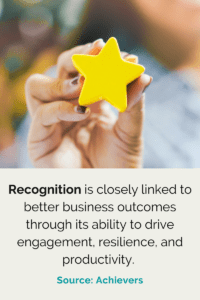A guide for HR leaders to becoming more resilient in 2023.
By Zee Johnson
There’s one workforce initiative that’s gaining major momentum and becoming a key priority for forward-thinking organizations in 2023. That initiative? Building resilience. While there are many strategies that leaders can leverage to reinforce their resilience, Achievers Workforce Institute’s (AWI) 2022 HR Preparedness Report shares practical and actionable ways to strengthen and inspire workforces in preparation for a possible recession and future uncertainty.
“A resilient workforce is one aspect of successfully navigating the challenges ahead,” says Achievers’ Chief Workforce Scientist Natalie Baumgartner. There are key areas businesses can focus on to heighten individual and organizational resilience.
Recognition
Recognition is closely linked to better business outcomes through its ability to drive engagement, resilience, and productivity. Leaders  can recognize their workforce in three steps.
can recognize their workforce in three steps.
- Quality and quantity. The report found that recognizing each employee at least once per month in specific, personal, and impact-oriented ways is most effective. This can be done by using systems that are both easily accessible and intuitive.
- Where it counts. It’s important to give recognition where employees are. This may mean utilizing different systems for online workers (Zoom, Slack, Teams) and offline workers (mobile apps).
- Support through communication. Adequate training and communication on a recognition program are critical for seamless adoption and regular usage.
Feedback
Employee feedback is essential for HR leaders to determine what changes need to be made and how they can go about making them. The report revealed that companies that act on feedback can triple their belonging rates and double productivity and resilience.
- Use methods like pulse surveys, Q&A sessions, and feedback panels to routinely gather feedback.
- Show employees that they’re being heard by reflecting their answers back to them and showing how what they shared will be used.
- Implement small actions that will have the most immediate impact on the employee experience. Acting where employees spend most of their time will be the most compelling.
Connection
Workers who say they are supported in building workplace relationships are two times more likely to report high individual resilience. They are also three times more likely to report high organizational resilience.
- Support socializing. Managers should facilitate team rapport building to connect and strengthen the relationships that are crucial to fostering resilience and productivity.
- Use networking tools. AWI’s Culture Report found that connection tools are the most sought-after technology for companies looking to bolster belonging. These tools are especially effective in dispersed workforces where employees may not meet in person regularly.
- Introduce Employee Resource Groups (ERGs). Employees who work where there are ERGs are three times more likely to say that their company supports them in developing and maintaining friendships at work. They are also three times more likely to say they are supported in developing a strong sense of belonging at work, making it a powerful DEIB tool.
Manager Effectiveness
An effective manager is a game-changer for an entire team. The right manager will be able to develop, support, and inspire employees to reach their greatest potential. AWI’s Manager Empowerment Model lists four key areas of focus that promote a wave of outstanding people leaders.
- Contact. Begin with positive feedback, like asking where assistance is needed. Then, personal and professional goals can be discussed, followed by several action items for managers to take with them and work on.
- Recognition. As with lower-level employees, recognition is critical for managers. In fact, AWI’s 2022 State of Recognition Report shows that regular recognition creates effective managers, prompting team members to be three times more likely to recommend their manager.
- Development. Employees are three times more likely to recommend their manager when their manager supports their professional development plan.
- Coaching. When managers are trained on coaching techniques, they have a better chance at developing and supporting their teams.
In addition to the above, organizations should ensure employees can easily identify a sense of purpose and a cultural alignment in order to reach their resilience goals. “Organizations that are able to align action to culture will find the path forward smoother than those who fail to connect their values to their decision-making process,” says Baumgartner.














